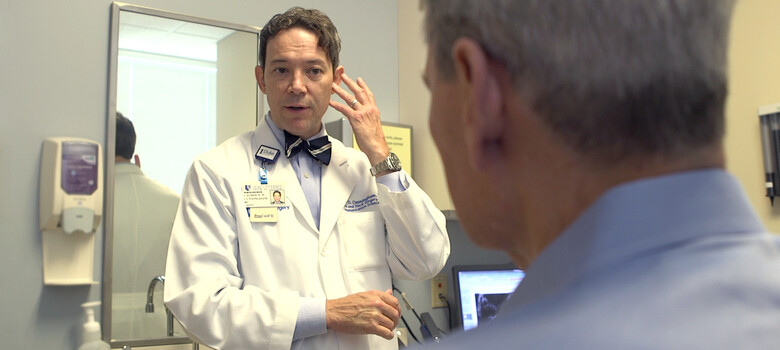Ear disease can range from simple to complex. For less-severe conditions like chronic ear infections, your doctor may suggest making lifestyle changes, trying medications, and treating contributing allergy or sinus disorders. If these don’t help or for more severe issues, your doctor may recommend surgery. Depending on their complexity, ear surgeries can be performed either through the ear canal or through a hidden incision behind the ear.
Ear Diseases
Common and Complex Ear Disorders and Treatment Options
or call
919-684-3834Without proper treatment, ear diseases can cause long-term and debilitating problems, including infection, hearing loss, vertigo (dizziness), and facial paralysis or weakness. Duke’s ear, nose, and throat (ENT) doctors (also called otolaryngologists) and specialty trained otologists/neurotologists diagnose and treat the underlying causes of these issues.
About Ear Disease Treatment
Duke Health offers locations throughout the Triangle. Find one near you.
Tests
Hearing Testing
Audiologists, who specialize in hearing loss, use different types of tests to learn whether you have hearing loss and, if so, whether it’s caused by problems in the eustachian tubes, outer ear, middle ear, or inner ear. They will chart your hearing test results on a graph called an audiogram.
Balance Disorder Testing
These noninvasive tests use sophisticated technology to measure your eye movements, ability to balance while standing, and reactions to movement and sound. The results help your doctor understand the cause and extent of your dizziness.
Imaging
CT imaging allows your doctor to get a detailed look at important bones in and around your ear. MRI images show the intricacies of softer tissues like nerves, inner ear fluids, and the brain.
Endoscopy
A small, flexible telescope with a camera on the end is inserted into the ear canal to give doctors a close-up look at the eustachian tubes and other ear structures.
Common Ear Procedures
Myringotomy Tubes (Ear Tubes)
Small tubes are surgically placed in the eardrum to allow fluid to drain from the middle ear, create a pathway for air to move freely, and prevent fluid buildup behind the eardrum. In adults, this routine procedure takes only 15 to 20 minutes and can be performed in your doctor’s office with just local anesthesia. Recovery only takes a day. Ear tubes typically fall out on their own within six to 12 months, although some may need to be surgically removed. If problems persist, the tubes may need to be replaced.
Tympanoplasty
Your eardrum can burst or tear due to severe ear infection, being poked with a foreign object, a dramatic and sudden change in air pressure, head trauma, or a loud noise. If this happens, your surgeon can repair the damage and rebuild the eardrum using a graft of skin or tissue from another part of your ear. Recovery time depends on the complexity of the surgery and can range from three weeks to six months.
Mastoidectomy
Your surgeon may perform this procedure along with a tympanoplasty if a cholesteatoma develops in the eardrum or middle ear. A cholesteatoma is a benign mass that if left untreated can damage your hearing and the mastoid bone that helps regulate air pressure inside the ear. Your surgeon will remove diseased portions of the mastoid bone as well as the cholesteatoma. The entire procedure lasts from two to four hours and requires general anesthesia. You may need to limit your activity for about a week afterward. Surgery for severe cases or repeat procedures should be performed by otologists/neurotologists.
Complex Ear Procedures
An otologist or neurotologist can also perform the following surgeries, which require additional training and expertise.
Stapedotomy
The stapes bone conducts sound vibrations to the inner ear. When an abnormal growth, called an otosclerosis, develops on the stapes bone, your surgeon may remove and replace it with a prosthetic bone to restore your hearing. The one-hour procedure can be performed through the ear canal with local or general anesthesia.
Balloon Dilation
Eustachian tubes are the main connection between the back of the throat and the middle of the ear. Normally, the tubes fill with air and open when yawning or chewing, allowing you to equalize pressure in your ears. Narrowed or blocked eustachian tubes may be widened using a treatment option called the Aera System. A small balloon is inserted into the eustachian tube and inflated by your surgeon, opening the passageway. Then the balloon is deflated and removed. This short procedure is usually done with general anesthesia, and it reduces the need for future surgeries.
Where you receive your care matters. Duke University Hospital is proud of our team and the exceptional care they provide. That is why our ear, nose, and throat (ENT) program is nationally ranked among the country's best hospitals, according to U.S. News & World Report for 2024-2025.
Why Choose Duke
Complex Care
Otolaryngologists are specially trained to perform delicate surgeries near vital nerves and muscles in the head, neck, and face. Otologists/neurotologists complete two years of training in addition to their ENT education, and specialize in treating complicated ear disorders and performing intricate ear surgeries. Together with audiologists, vestibular specialists, neurologists, neurosurgeons, and other specialists, Duke’s ear experts provide high-quality ear care.
Advanced Technology
From testing to surgical techniques, our experts use specialized tools to increase accuracy and reduce risk. Because ear structures are very small and difficult to see with the naked eye, our surgeons use powerful operating microscopes that allow them to see things in minute detail.
Intraoperative Monitoring
We use electrophysiologic measures to monitor the integrity of the brain, spinal cord, or peripheral nerves during surgery. This helps reduce the risk of surgical complications.

